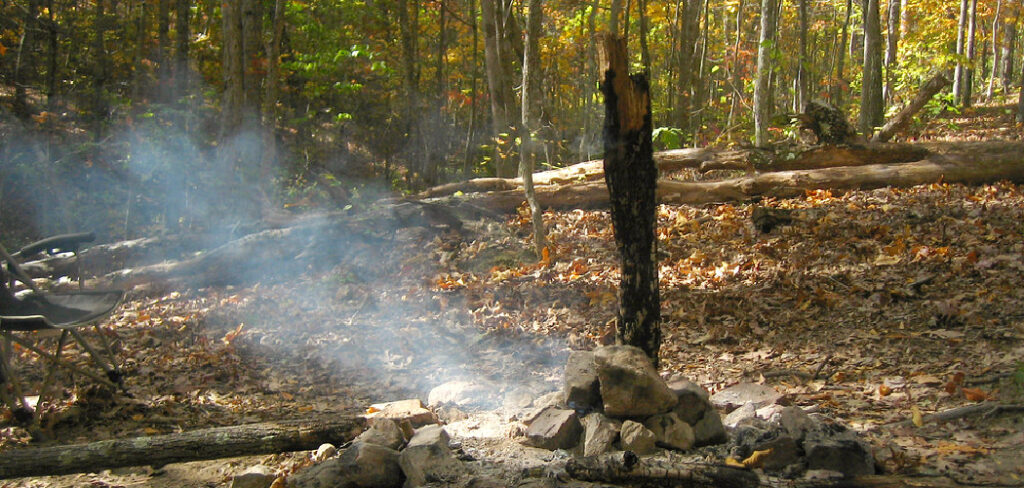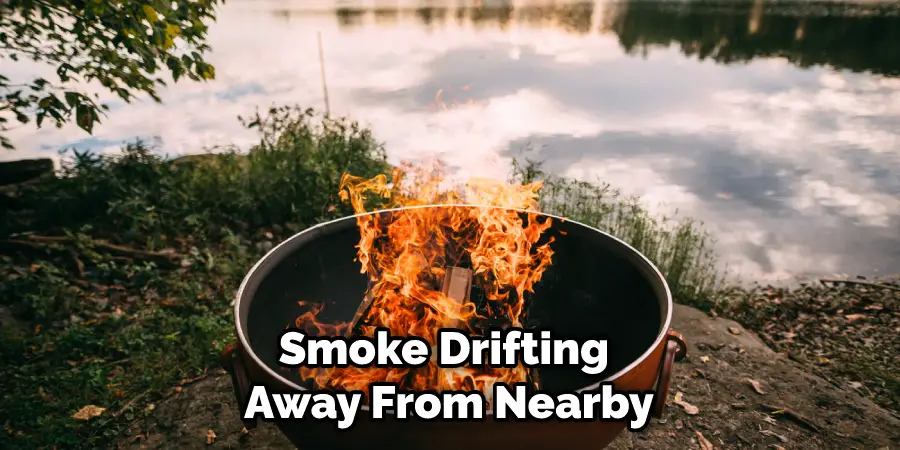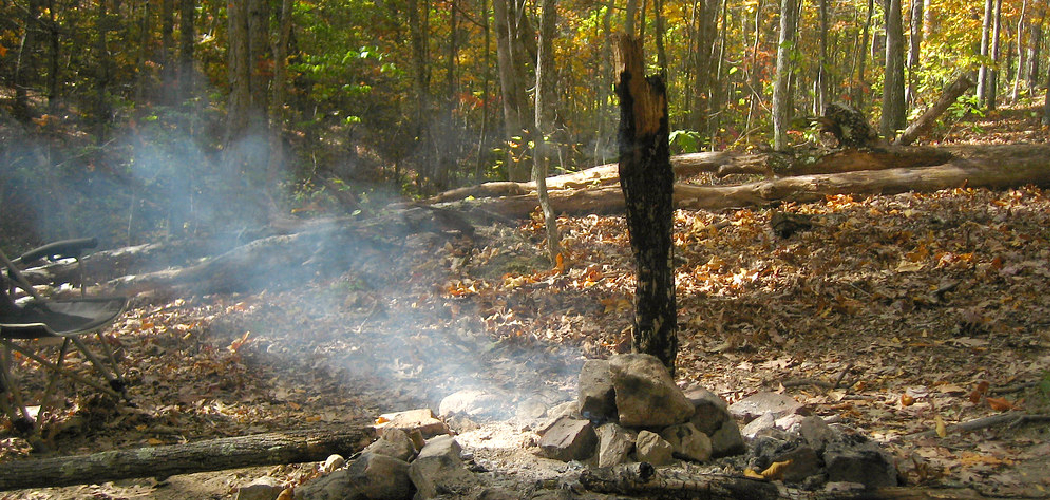
When the weather starts to get cooler and you’re in the mood for some roasting marshmallows, a fire pit is an excellent addition to any outdoor space. But one common problem that many homeowners experience with their fire pits is smoking.
It is important to know how to stop fire pit smoking.
Smoke pouring out of the pit not only ruins the atmosphere but can also be a health hazard if left unchecked. Fortunately, there are simple steps that you can take to stop your fire pit from smoking so you can enjoy a pleasant and safe evening around your backyard campfire. In this blog post, we’ll cover why fire pits smoke and how to prevent it.
Tools You Will Need
- Chimney cover
- Fire pit screen
- Dry, seasoned firewood (avoid softwoods)
6 Steps Guide on How to Stop Fire Pit Smoking
Step 1: Check Your Firewood
If you’ve ever experienced fire pit smoke, you know just how unpleasant it can be. Luckily, there’s an easy solution to the problem that is often overlooked – checking your firewood before using it in the pit.
Taking a minute to inspect your wood for dampness and insects can make all the difference when it comes to reducing smoke. While small amounts of moisture are all but unavoidable, larger quantities will cause smoke as the wood won’t burn efficiently.
Additionally, keeping an eye out for insect infestation will help you avoid inhaling any of their by-products as they combust. Storing your firewood far from groundwater sources is a great way to ensure it’s properly dried out before use.
Taking these steps leads to much more enjoyable evenings around either a campfire or backyard fire pit – no more coughing and irritated eyes!
Step 2: Don’t Overfill The Fire Pit
Overfilling a fire pit only leads to one thing – more smoke. As the amount of fuel rises, smoldering time increases, causing excessive smoking and lots of discomfort for those around it.

Additionally, when fire pits are too full of wood or charcoal, heat does not escape and can produce dangerous sparks or uncontrollable flames.
So if you want to enjoy your outdoor experience without all the coughing and irritation from smoke, simply use a smaller portion of the fuel. This will reduce smoke levels greatly and keep your outdoor space in tip-top shape!
Step 3: Create A Good Airflow
Keeping your fire pit from smoking can be done relatively easily with a few precautions. An important factor in helping to reduce smoke is making sure your fire pit has good airflow. Allowing as much oxygen as possible to reach the fire helps oxygenate the flames, keeping them dense and bright, which reduces the amount of smoke produced.
Additionally, make sure there is plenty of space between logs and other materials added to the flame, as too much fuel can result in an air-deprived fire that produces more smoke. Additionally, regular maintenance such as cleaning out ashes and brushing off soot are useful steps toward limiting smoky fires.
This will ensure that enough oxygen can get through a large pile of ash or soot to help keep your flame alive and clear. Finally, make sure not to overload the fire pit with too much wood or material.
This will provide the appropriate amount of room for enough oxygen to reach your fire, ensuring it stays lit for longer and thoroughly burns material for minimal smoke production.
Step 4: Monitor The Flame Height
Keeping an eye on the height of fire pit flames can make a big difference in terms of smoke, odor, and overall safety. When a flame rises above the top of the fire box, it not only produces more smoke but combustible elements like creosote and soot that settle on nearby surfaces may become ignited and start a fire.
With this knowledge in mind, proper burn practices should always be followed when using a fire pit to ensure that your family and home are safe from any accidental fires. Monitoring and adjusting the flame regularly can help to reduce or eliminate smoke as well as decrease odors caused by burning wood.

The heat can also be better managed if you keep an eye on how high it is rising. Following these simple tips will help increase the use of your outdoor fire pit while keeping safety as your priority.
Step 5: Don’t Put Trash In The Pit
It is important to avoid disposing of trash in fire pits to prevent smoking. If you find that your fire pit is producing thick gray smoke, the first step is to check what kind of wood you are using.
As wood burns, the material produces chemicals and particles called smoke, so the type of wood being burned can significantly contribute to smoke production.
Make sure that you select an appropriate “smokeless” or low-smoke variety before continuing. Additionally, the paper should never be used as fuel because it creates a lot of unnecessary smoke. Once the wood is taken into account, check for any foreign objects inside the fire pit that could be catching on fire and causing additional irritation to those around it.
Things like leaves, pine needles, and other debris should not be allowed in the fire as they don’t break down completely and will cause additional smoking. Careful attention and constant vigilance can help ensure that everyone has a pleasant experience around a campfire.
Step 6: Keep The Fire Small
Enjoying a cozy evening around the fire pit doesn’t have to disrupt your entire neighborhood with thick smoke.
To keep your fire pit from smoking, it’s important to start by using small pieces of dry wood and kindling instead of large logs. You should also ensure there is plenty of airflow by stacking logs in such a way that it leaves plenty of space between each piece.

Before lighting up, check the wind direction and try to create a windbreak if possible to keep the smoke drifting away from nearby homes or buildings. Finally, avoid using artificial accelerants such as gasoline or lighter fluid; they will only make the toxic smoke much worse.
Following these tips will help you savor that campfire taste without irritating neighbors who aren’t looking for a classic smoky campfire experience!
Additional Tips to Stop Fire Pit Smoking
- Check the wind direction before lighting your fire pit. If the wind is blowing toward your house or toward your neighbor’s house, it will cause the smoke to blow in that direction as well.
- Make sure the area around your fire pit is clear of any debris that could catch fire. This includes leaves, sticks, and paper.
- Only use dry wood in your fire pit. Wet wood will produce more smoke than dry wood.
- Don’t build a big fire all at once. Start with a small fire and add more wood as needed. A big fire will produce more smoke than a small fire.
- Keep the lid on your fire pit while it’s burning. This will help to contain the smoke and prevent it from spreading.
- Don’t let your fire burn for too long. Once it’s burned down to embers, you can extinguish it with water.
- Don’t put garbage in your fire pit. This includes things like cans, bottles, and plastic wrappers. They will produce toxic fumes when burned.
- Be careful when adding chemicals to your fire pit. Some chemicals, like lighter fluid, can make the smoke worse.
- Avoid using treated wood in your fire pit. Treated wood has been treated with chemicals that can be released into the air when burned.
How You Can Avoid Toxic Fumes from Your Fire Pit?
Burning wood in fire pits creates warm and cozy atmospheres, but it can also be dangerous due to the toxic fumes emitted. If you want to enjoy your evenings by the fire pit without having to worry about unhealthy air, there are a few measures you can take.
You should use properly-seasoned hardwood since unseasoned or softwood produces more smoke and burn hotter than seasoned wood. Burning short logs is also better than long logs since they require less oxygen and produce fewer pollutants.
Lastly, keep the flames low while burning: the hotter the flame burns, the more smoke it creates. By following these simple tips, you can make sure that your fire pit experience is as safe as enjoyable!
How to Enjoy a Pleasant Campfire Experience Without the Smoke?
Campfires are a great way to spend time with friends and family, creating memories that can last forever. But how do you enjoy a pleasant campfire experience without the smoke?
One thing you can do is gather up stones and place them around where your fire will be built – these stones will absorb the heat from the flames and help create an even burn and less smoke.

You can also use dry wood, split it into smaller pieces, don’t cover the fire in logs, and focus on building a small, contained flame. Layout your kindling so that there are gaps for oxygen to reach the fire, adding larger logs once the fire is going well.
Finally, add wet or green wood sparingly as both create more smoke than dry wood. With these tips in mind, you’ll be sure to have an enjoyable campfire experience free of smoke!
Conclusion
If you find your fire pit smoking, there are a few things you can do to stop it. Try blowing gently into the center of the fire from about four inches away. You should carefully determine how to stop fire pit smoking.
You can also try wafting a piece of cardboard around the edge of the pit until the smoke subsides. If all else fails, call a professional to help get your fire going safely and without smoke. With these tips in mind, you should be able to keep your firepit looking great and performing better than ever.
You Can Check It Out to Extinguish Fire Pit
About
Outdoor Fixes is a distinguished figure in the world of Diy design, with a decade of expertise creating innovative and sustainable Diy solutions.
His professional focus lies in merging traditional craftsmanship with modern manufacturing techniques,
fostering designs that are both practical and environmentally conscious. As the author of diy,
outdoorfixes delves into the art and science of outdoorfixes-making, inspiring artisans and industry professionals alike.
Education RMIT University
(Melbourne, Australia) Associate Degree in Design (Outdoor Fixes) Focus on sustainable design, industry-driven projects,
and practical craftsmanship. Gained hands-on experience with traditional and digital manufacturing tools, such as CAD and CNC software.
Nottingham Trent University
(United Kingdom) Bachelor’s in outdoorfixes.com and Product Design (Honors) Specialized in product design with a focus on blending creativity with production
techniques. Participated in industry projects, working with companies like John Lewis and Vitsoe to gain real-world insights.
Publications and Impact
In diy, Outdoor Fixes his insights on indoor design processes, materials, and strategies for efficient production.
His writing bridges the gap between artisan knowledge and modern industry needs, making it a must-read for both budding designers and seasoned professionals.

